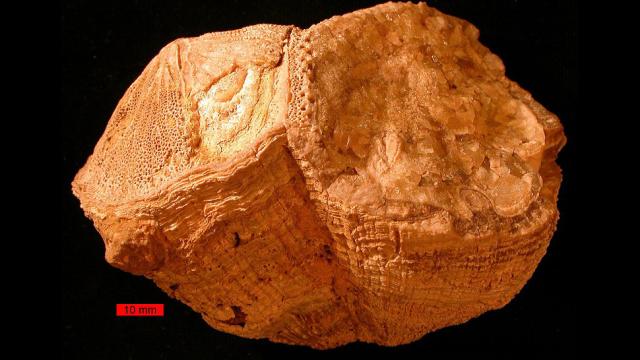During the Late Cretaceous, days were roughly 30 minutes shorter than they are today, according to chemical traces found on a 70-million-year-old shell belonging to an extinct mollusk.
Like counting the rings of a stump to discern the age of a tree, scientists from the Environmental and Geochemistry Research Group at Brussels University have counted the microscopically thin layers of an extinct mollusk to calculate the length of a Late Cretaceous day. The new paper, published in Paleoceanography and Paleoclimatology, shows that, some 70 million years ago, days were around 23.5 hours long and that the Earth rotated 372 times each year, as opposed to the current 365 days per year.
The overall length of the year hasn’t changed since the Late Cretaceous”a total year consisted of 8,760 hours during the Late Cretaceous, just as a year does today. It’s just that our planet’s spin is getting progressively slower, thanks to the gravitational effects of our Moon. Accordingly, the new research, led by Niels J. de Winter, could improve our understanding of the Earth-Moon relationship over time and even the timing of the origin of the Moon.
That days were shorter tens of millions of years ago is hardly a revelation. The new study is important in that it improves the accuracy of pre-existing estimates, while providing a new way of studying the past.
“Previous estimates were based on counting daily laminae [growth layers] similar to the ones we did chemical analyses on,” de Winter told Gizmodo. “This [previous] counting yielded roughly the same number of days per year, but with different countings yielding differences up to 10 days due to human error and the difficulty in recognising daily layers by eye.”
Key to the research was a single fossil shell belonging to Torreites sanchezi, a rudist clam. Now extinct, rudists were shaped like boxes, tubes, and rings, and they filled an ecological niche currently occupied by coral reefs. T. sanchezi grew very quickly as far as hinged, or bivalve, mollusks are concerned, exhibiting thin layers of daily growth rings.
The single fossil used for the current study came from a specimen that lived in the warm waters of a tropical seabed, and it died at the age of 9 years. The fossil came from the Samhan formation in Oman, which dates back some 70 million years ago. Looking at samples of the specimen through a microscope, the researchers were able to see the daily growths, which measured 40 nanometres wide. That sounds thin”and it is, by human standards”but that’s actually thick for a bivalve, allowing for a well-preserved chemical record in the fossil shell calcite.
“Trees deposit a layer of wood every year, and you can see these layers when you cut a slice out of a tree. By counting the layers from the outside towards the inside of the tree stump, one can estimate the tree’s age,” explained de Winter. “In a similar way, we could count the days and years in Torreites sanchezi by counting the layers. Our chemical analyses of the layers allowed us to do this with great precision and take away the error that occurs when counting these layers by eye through a microscope.”
The researchers also chronicled seasonal patterns in the shell, which allowed them to identify yearly cycles.
Incredibly, the researchers were able to spot approximately four to five data points for each day, allowing for an extraordinary level of fidelity. What’s more, these daily cycles showed that the most growth happened during the day as opposed to night and that seasonal environmental influences weren’t a significant factor for growth. Taken together, this means T. sanchezi was particularly sensitive to the day-night light cycle. The scientists have taken this as evidence for the presence of a symbiotic life form, likely a photosynthesizing algae, that lived in concert with the organism.
“We learned that these rudist bivalves, or at least this species… had these photosymbionts, just like corals have today,” de Winter told Gizmodo. “This is quite rare for a bivalve, and not many species have this. It helps us understand how these bivalves could become so successful and how they could take over the role of reef builders from the corals in the time of the dinosaurs.”
Excitingly, the new study is a kind two-for-one, offering new data to support a pair of pre-existing theories: the shorter Cretaceous Earth day and the symbiont.
“Until now, all published arguments for photosymbiosis in rudists have been essentially speculative, based on merely suggestive morphological traits, and in some cases were demonstrably erroneous,” explained Peter Skelton, a retired paleontologist from The Open University, in a press release. “This paper is the first to provide convincing evidence in favour of the hypothesis,” said Skelton, who wasn’t involved with the new study.
The new paper also shows that chemical analyses can be used by scientists to “more accurately count these daily and yearly layers in fossil shells to estimate how many days are in a year in the geological past,” said de Winter. This will allow scientists to “see how the rotation of Earth and Moon evolved over long timescales” and to “ultimately understand how the Moon formed.”
[referenced url=” thumb=” title=” excerpt=”]
Indeed, Earth’s spin is slowing down, and the days are getting longer, owing to the tidal effects exerted by our natural satellite. At the same time, the Moon is steadily collision during Earth’s infancy some 4 billion years ago.
Clearly, many questions remain about the Earth-Moon relationship, how it’s changed over time, and the celestial dynamics that continue to dictate this gravitational union. Ideally, scientists will continue to gather more data to better reconstruct historical models of the Earth-Moon system. Incredibly, and as the new research suggests, the answers to these questions may be waiting inside our planet’s oldest fossils.
